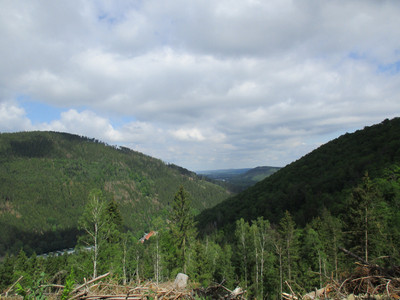Circular hike through the Oker valley.
NATURA Tip 13 Rocks and cliffs in the Oker valley
Short facts
- start: Waldhaus Oker
- destination: Waldhaus Oker
- medium
- 9,38 km
- 3 hours
- 492 m
- 235 m
- Loop tour
best season
Tour waypoints
Klettergebiet Okertal
117 Treppenstein
Malerblicke im Harz - 24. Romkerhaller Wasserfall
Königreich Romkerhall
116 Verlobungsinsel in der Oker
Malerblicke im Harz - 23. Okertal Talweg
Tour-Dashboard
Pavings
- Hiking Trail (9%)
- Street (8%)
- Path (10%)
- Crushed Rock (45%)
- Asphalt Coating (28%)
Weather
General information
We begin our circular hike at the car park of the former Waldhaus hotel. There we cross the bridge. If you're lucky, you can observe a dipper searching for food in the riverbed of the Oker. Just behind the bridge, an information board explains the former use and development of the Oker valley. Up until 1866, timber was floated down the Oker. Since the Oker dam regulates the water flow to protect Wolfenbüttel and Braunschweig from floods or to balance low water levels, this is no longer possible. From the mid-19th century, numerous wood grinding mills were established in the Oker valley. Although repurposed over time, some of the buildings originally used for this are still preserved. Behind the bus stop, on the opposite side of the street, we follow the Harzklub hiking trail 6J (blue triangle). Our path leads slightly uphill. On the left side of the path grow garlic mustard and nettle. Both indicate nutrient-rich growing conditions. While the former fell into oblivion, nettle is nowadays simply unpopular. Yet both plants were indispensable for poor people in the past. The nutritious nettle made an important contribution to survival in difficult times as it contains more iron than spinach, more calcium than cow's milk, more vitamin C than oranges, is also very rich in protein and grows almost everywhere. Those who want to try it themselves should pinch a leaf underneath with their forefinger and thumb, fold it multiple times, and squeeze it firmly. This destroys the stinging cells, and the "nettle candy" can be safely eaten. Garlic mustard was once a staple in every herb garden, as spices like pepper and salt were luxury goods.
Steeply up to the Oker cliff path
Flavouring was done with herbs. Garlic mustard (Alliaria officinalis), also called jack by the hedge or garlic hedge mustard, belongs to the cruciferous family like mustard (Brassica nigra). Usable are the garlic-flavoured leaves and their seeds. Ground seeds were used as a substitute for pepper. To the right of the path, near a small stream, we can spot fire salamanders. Wood horsetail grows where it's moist. We continue uphill and soon see a large windthrow area on the left. Naturally, deciduous trees would grow here; the shallow-rooted spruces are not native but were planted. Further on, we reach a junction where the Old Harz Road branches off to the right. It was built in 1817 according to plans by chamber secretary von Eschwege to facilitate timber transport and promote traffic in the Upper Harz. We stay on the main Harzklub hiking trail 6K (blue triangle) and continue uphill. The trail turns right after a few metres, through a windthrow area. A very steep ascent leads us to the narrow Oker cliff path and then to the impressive Ziegenrücken cliffs. Like most of the following cliffs, they consist of white-grey Oker granite. The grey, transparent parts are quartz crystals. The white crystals are feldspar, and the black components belong to the mica minerals. Rock is by definition a solid mixture of different minerals. To remember which minerals granite consists of, just recall: "Feldspar, quartz and mica, these three I never forget!" Passing the Devil’s and Students' cliffs, we reach the Treppenstein. At the Treppenstein is stamp station no. 117 of the Harz hiking network.
From the Treppenstein to Romkerhall
Climbing the cliffs via the narrow, namesake stairs is worth it for the view alone. Various lichens colonize the rock, including the map lichens typical for the habitat type of silicate rocks with rock crevice vegetation. Rowans grow in the crevices. Opposite are the Students' cliffs clearly visible, since a few years ago they were carefully cleared by the Lower Saxony State Forests with support from the Goslar district’s lower nature conservation authority, together with numerous other cliffs. Unnoticed, with the Treppenstein, we have also entered the eastern part of the bird protection area "Cliffs in the Oker valley". The larger part of the reserve is west of the Oker between the Dusky Valley in the north and the Romkerhalle storage power plant in the south and coincides with the FFH area "Rocks in the Oker valley". Passing the Große Kurfürst cliff and other cliffs and rocks, we reach the Schöppenstedter Way. It leads us to the Romke cliff. From here, water diverted from the Kleine Romke drops about 65 m deep. The Romkerhall waterfall is the highest artificial waterfall in the Harz. From the Romke cliff, we look at the opposite Raben cliffs. On the east-facing slope visible to us, partly treeless and developed as block slopes, hardened black clay shales (hornfelses) outcrop. Here, the habitat types dry European heaths and siliceous scree slopes of Central European mountain areas develop. On the west slope, typical plant communities of calcareous rocks with rock crevice vegetation can be found. We choose the steep descent into the Oker valley. At the foot of the waterfall, the Siberian iris blooms in late spring.
Across the Engagement Island back to the Waldhaus
Romkerhalle as a place name was established only in 1863 with the opening of the now considerably aged guesthouse. The name "Kingdom Romkerhall" is a reference to the location of the house in the unincorporated area of the Harz, today managed by the Lower Saxony forestry office Clausthal. We take the Harzklub hiking trail 6F (red triangle) towards Engagement Island. For the 4 km back to the starting point of our circular hike, surefooted, closed footwear is essential. We walk many times on bare rocky terrain! If lucky, you experience the Oker as a roaring wild river. This is always the case when, at peak times, water flows through the turbines of the storage power plant. On both sides of the path grow woodruff, wood-rush, common hawkweed and the spike devil’s claw. Brown trout swim in the river. The varied path leads us to Engagement Island (stamp station 116 of the Harz hiking network). Shortly after, we reach a reservoir that ensures the all-day supply to the downstream hydropower plants. Behind the dam, the path descends steeply. It leads past the Marienwand. Climbing is generally allowed here, but the closure periods to protect breeding peregrine falcons must be strictly observed. Along the road, we reach the impressive Adler cliffs. Besides the adventurous path, the aqueduct standing on stilts and partly cut through the rock fascinates. As at the time of the first commissioning, it serves the even water supply of the grinding mills, where nowadays only electricity is generated. Following the path along the Oker finally brings us back to the starting point of our hike, the Waldhaus.
At the Waldhaus Oker.
Tourist Information Goslar in the historic town hall
Markt 1
38640 Goslar
Tel: 05321 78060
marketing@goslar.de

